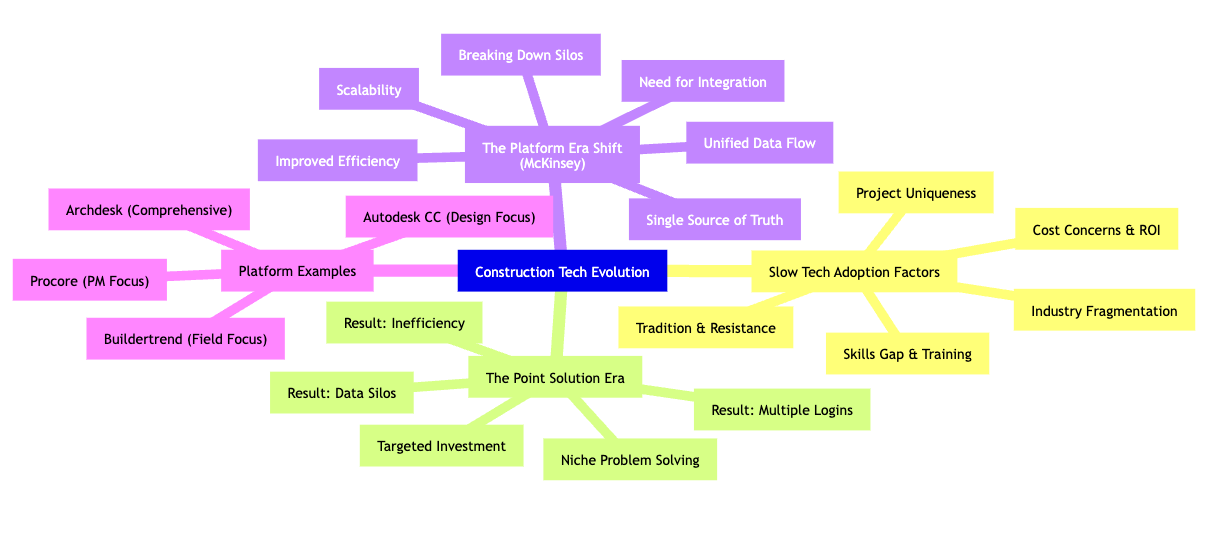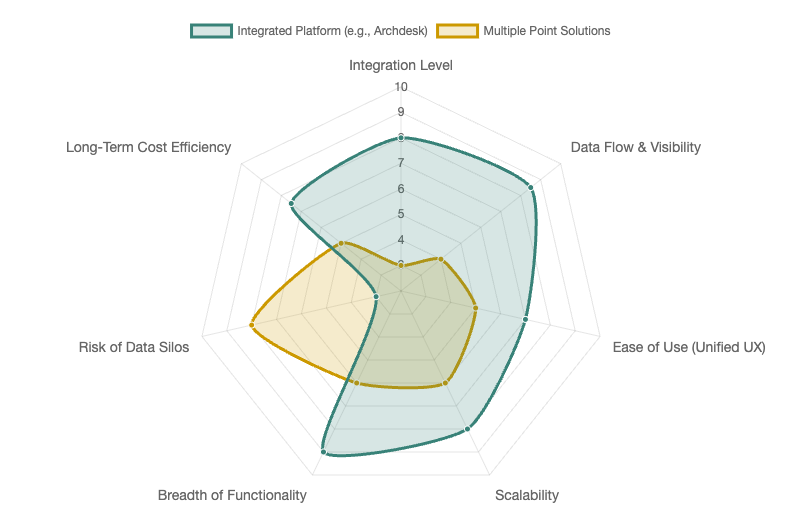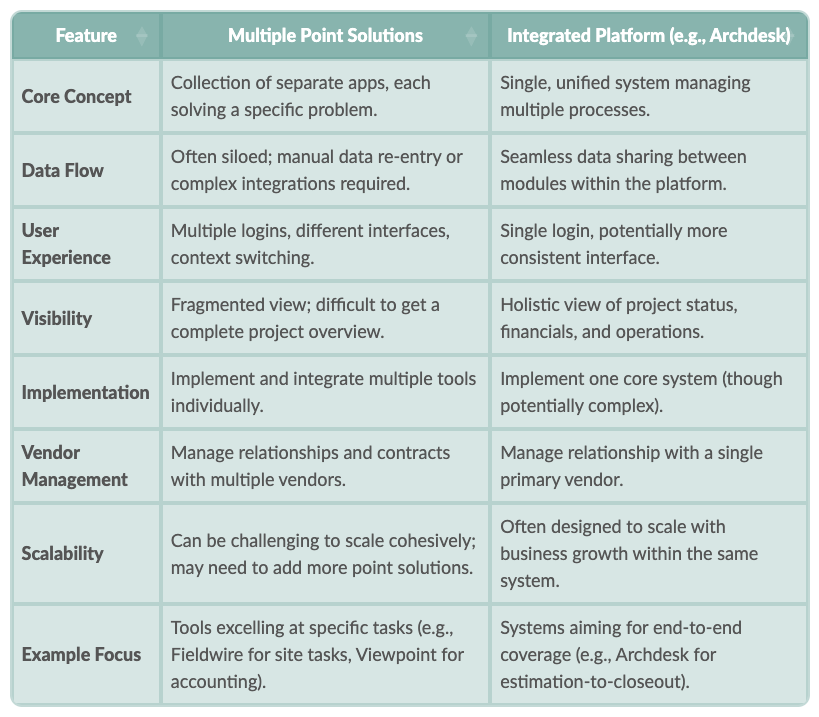From scattered apps to unified platforms: Unpacking the big shift in construction software (and why it matters).
Let's be honest, the construction industry hasn't exactly been the Usain Bolt of technology adoption. While other sectors were busy swiping, clicking, and automating, construction often felt like it was happily humming along with processes established when blueprints were, well, actually blue. If you've ever felt like you're managing a multi-million dollar project with tools that belong in a museum, you're not alone.
But things are changing. There's a noticeable shift happening, moving away from a jumble of single-purpose apps towards more all-in-one solutions. We're talking about the move from scattered "point solutions" to integrated "platforms," like Archdesk. Inspired by insights like those in McKinsey's article on the "platform era," let's dive into why construction tech took the scenic route, why the landscape was littered with single-task apps, and why the future looks a lot more connected.
Highlights: Key Takeaways
- Slow Tech Uptake Reasons: The construction industry's tech adoption has been hampered by tradition, fragmentation, cost concerns, and resistance to change within the workforce.
- The Point Solution Problem: A flood of niche apps solved specific problems but created data silos and inefficiencies, forcing teams to juggle multiple disconnected tools.
- The Platform Shift: The industry is moving towards integrated platforms like Archdesk to break down silos, improve data flow, and provide a unified system for managing projects from end to end.
Why Was Construction Tech Stuck in First Gear?
It's Not Laziness, It's Complicated...
So, why the hesitation? It wasn't just about being stubborn or technophobic. Several real-world factors have traditionally pumped the brakes on tech adoption in construction.
Deeply Rooted Traditions (and an Aging Workforce)
Construction is built on centuries of tradition. "This is how we've always done it" isn't just a saying; it's often a deeply ingrained workflow. Convincing seasoned veterans, who perfected their craft long before smartphones existed, to ditch their trusty clipboard or spreadsheet for a new app can be a tough sell. There's a comfort in the familiar, especially when profit margins are tight and experimenting feels risky.
The Fragmentation Puzzle
Think about a typical construction project: owner, architect, general contractor, dozens of subcontractors, suppliers... it's a complex web of independent entities. Each company often has its own preferred methods and tools. Getting everyone onto the same digital page? It's like herding cats, if the cats all spoke different languages and used different scheduling apps. This fragmentation makes standardizing technology across a project incredibly challenging.
Cost Concerns and Unclear ROI
New technology often comes with a significant price tag – software licenses, hardware upgrades, and crucial training time. For many construction firms, especially smaller ones operating on thin margins, this upfront investment can seem daunting. If the return on investment (ROI) isn't immediately clear and guaranteed, sticking with the tried-and-tested (even if less efficient) methods often wins out.
The Learning Curve and Skills Gap
Introducing new tech requires training. In an industry facing labor shortages, pulling teams off-site for software training isn't always feasible. Plus, there can be a skills gap; not everyone is comfortable navigating complex software interfaces. The perceived hassle of implementation and onboarding can be a major deterrent.
The "App-ocalypse": Why So Many Single-Purpose Tools?
Solving One Problem at a Time... Creating Others
As technology began seeping into construction, it often arrived in the form of "point solutions." These are specialized software tools designed to tackle one specific problem really well. Think:
- An app just for daily reports.
- Software solely for estimating.
- A tool focused only on scheduling.
- A system dedicated to document management or RFIs.
Companies like Fieldwire became known for field management, Viewpoint for accounting, or early versions of Procore and Autodesk Construction Cloud focused heavily on specific areas like project management or design collaboration.
The Rise of Niche Solutions
Why did this happen? Early tech investors and developers saw clear, specific pain points in construction (like tedious paperwork or poor communication) and built targeted solutions. These were often easier to develop and sell than massive, all-encompassing systems. For a while, it seemed like progress – finally, a digital tool for *that* specific headache!
The Downside: Data Silos and Digital Duct Tape
The problem? These point solutions rarely talked to each other. Information entered into the scheduling app didn't automatically update the budget tracker. Documents stored in one system weren't easily accessible from another. This created "data silos" – isolated pockets of information trapped within individual applications.
The result? Teams ended up juggling multiple logins, re-entering data across different platforms (hello, errors!), and struggling to get a complete, real-time picture of the project. It was like having a toolbox filled with incredibly specialized screwdrivers, but no single tool that could handle multiple types of screws, forcing you to constantly switch back and forth. Efficient? Not so much.
Visualizing the Adoption Challenges and Platform Shift
The journey from traditional methods to integrated platforms involves navigating various industry hurdles and embracing new ways of working. This mindmap illustrates the key factors driving this evolution:

Enter the Platform Era: Connecting the Dots
Why All-in-One is Becoming the Go-To
Frustration with the limitations of point solutions paved the way for the rise of integrated construction management platforms. As highlighted in the McKinsey article, the industry is recognizing the immense value of bringing disparate functions together under one digital roof. This isn't just a trend; it's a fundamental shift driven by the need for greater efficiency, visibility, and control.
What is a Platform Approach?
Instead of a collection of separate tools, a construction platform aims to be a comprehensive, interconnected system. It integrates various functions – like estimating, procurement, project management, scheduling, cost control, document management, and even financials – into a single environment. Think of it as upgrading from that messy toolbox of single-purpose gadgets to a sophisticated, organized workshop where all the tools work together seamlessly.
Solutions like Archdesk are built on this principle, designed from the ground up to manage the entire project lifecycle within one system. While competitors like Procore or Autodesk Construction Cloud have expanded their offerings over time, often through acquiring point solutions, a truly integrated platform provides a more cohesive experience, minimizing the "bolted-together" feel.
Why the Shift? The Benefits are Clear
- Breaking Down Silos: The biggest win. Platforms allow data to flow freely between different modules. An approved change order can automatically update the schedule and budget, without manual re-entry.
- Single Source of Truth: Everyone works from the same, up-to-date information, reducing confusion, miscommunication, and costly errors based on outdated data.
- Improved Efficiency: Less time spent switching between apps, duplicating data entry, or hunting for information means more time spent on actual construction tasks.
- Better Visibility & Reporting: With data centralized, managers get a clearer, holistic view of project health, performance, and potential risks.
- Scalability: Platforms are often designed to grow with a business, accommodating more complex projects and expanding teams without needing to add a patchwork of new point solutions.
- Potentially Lower TCO: While the initial investment might seem comparable, managing a single platform subscription can be simpler and potentially more cost-effective in the long run than juggling multiple licenses, integrations, and training schedules for various point solutions.
Comparing Approaches: Platforms vs. Point Solutions
The choice between relying on multiple point solutions versus adopting an integrated platform involves trade-offs. This radar chart visualizes a general comparison across key attributes, showing how platforms typically aim for broader, more integrated capabilities.

This chart illustrates the general advantages platforms offer in terms of integration and holistic data management compared to the fragmented nature of using multiple point solutions.
Feature Comparison: Point Solutions vs. Integrated Platforms
To further clarify the differences, here's a table summarizing the typical characteristics of each approach:

Frequently Asked Questions (FAQ)
What exactly are 'data silos' and why are they bad?
Think of data silos like separate containers holding different pieces of project information that don't connect. For example, your estimating team uses one software, your project managers use another for scheduling, and accounting uses a third for costs. Information created in one system (like a cost estimate) isn't automatically available or updated in the others. This forces people to manually re-enter data (risking errors), leads to decisions based on incomplete or outdated information, and makes it incredibly hard to get a real-time, accurate overview of the entire project. Breaking down these silos with an integrated platform means data flows automatically, reducing errors and providing a single source of truth.
Isn't switching to a big platform really expensive and disruptive?
There's definitely an investment involved in adopting a platform – both in terms of cost and the time needed for implementation and training. However, it's important to consider the hidden costs of *not* switching. Think about the time wasted juggling multiple apps, the cost of errors from manual data entry, the inefficiencies from poor communication, and the subscription fees for numerous point solutions. While the upfront step to a platform can seem significant, the long-term benefits in efficiency, error reduction, better decision-making, and streamlined vendor management often lead to a positive return on investment and lower total cost of ownership (TCO) compared to maintaining a fragmented tech stack.
Will platforms completely replace all specialized point solutions?
Probably not entirely, but the trend is towards consolidation. Core functions like project management, financials, scheduling, and document control are increasingly being integrated into platforms. Highly specialized niche tools (e.g., advanced structural analysis software or very specific estimating tools for unique trades) might still exist. However, the key difference is that modern platforms are often built with integration capabilities (APIs) in mind. This means even if you need a specialized tool, it can potentially connect and share data with your central platform, reducing the silo effect. The goal is a connected ecosystem, with the platform serving as the central hub, rather than a collection of completely isolated apps.
We're a smaller contractor. Are platforms only for large companies?
Not anymore! While early enterprise systems were often geared towards large firms, many modern platform providers, including Archdesk, offer solutions tailored for small to medium-sized businesses (SMBs). These might come in tiered packages or specific versions (like Archdesk Essentials) designed to provide core platform benefits – integration, reduced silos, better efficiency – at a price point and complexity level suitable for smaller teams. The fundamental problems of juggling information and needing efficiency exist regardless of company size, so platforms are increasingly accessible and beneficial for contractors of all scales.
References
- Rise of the platform era: The next chapter in construction technology - McKinsey
- Platform vs. Point Solutions in Construction Software | Archdesk Blog - Archdesk
- Why Is Construction Slow to Embrace New Technology? - ConstructoWiki
- 6 reasons why the construction industry is slow to embrace technology - Under the Hardhat
- Archdesk Construction Management Software - Archdesk





